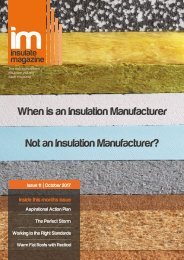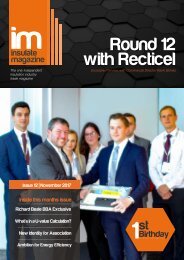IN_Dec_18_Final_SP
An Insulation Evolution is upon us in Insulate Magazine Issue 13. Q-bot a Robot that applies sprayfoam insulation under floors is set to take the insulation world by storm. Also features compelling articles from regular columnists and insulation experts.
An Insulation Evolution is upon us in Insulate Magazine Issue 13. Q-bot a Robot that applies sprayfoam insulation under floors is set to take the insulation world by storm. Also features compelling articles from regular columnists and insulation experts.
Create successful ePaper yourself
Turn your PDF publications into a flip-book with our unique Google optimized e-Paper software.
The only independent insulation industry trade magazine<br />
Insulate insulate Columnist columnist<br />
Hackitt Review Must Put Maximum<br />
Public Safety First and Foremost<br />
Sarah Kostense-Winterton Executive Director, MIMA<br />
With the Hackitt interim report expected before Christmas, we all have high hopes for<br />
Dame Judith’s independent review. What is clear is that we simply cannot and must not<br />
compromise on public safety.<br />
As the organisation representing the non-combustible insulation manufacturers, MIMA is firmly supportive<br />
of the scope of the Building Regulations review but believes we need to be more stringent, albeit<br />
prescriptive with particular attention being given to all mid- and high-rise, sensitive and high occupancy<br />
buildings such as schools, hospitals and care homes.<br />
Fit for purpose?<br />
We need to go wider with a review that fully considers<br />
the implications for fire safety in technology advances.<br />
Current developments in technology mean it is perfectly<br />
practical to track a product from factory to installation<br />
while keeping a digital record of what the product characteristics<br />
are. A record for current and future building<br />
occupants.<br />
We should consider whether wider testing methodologies<br />
are fit for purpose. Specifically focusing on whether the<br />
testing regimes applying in all buildings are only testing a<br />
perfect installation rather than a ‘real world’ one.<br />
Current regulations are ambitious<br />
Currently ‘guidance’ for facades in buildings over <strong>18</strong>m<br />
high sits in multiple documents with Approved Document<br />
B referencing a variety of supporting documents which<br />
don’t lead to clear guidance on what is or isn’t permitted.<br />
To offer maximum public safety, the approved document<br />
should offer the only point of reference and the only permissible<br />
routes to compliance should be the use of Euroclass<br />
A1 or A2 rated products on facades which should<br />
be clearly set out in a redrafted Approved Document B.<br />
That redrafting should also clearly set out that Approved<br />
Document B is the only acceptable route to compliance<br />
Routes to compliance<br />
Approved Document B is not the only means to<br />
compliance with the Building Regulations – other bodies<br />
are permitted to publish their own guidance on how the<br />
regulations can be met. This has led to industry bodies<br />
publishing their own guidance on BR135 – these guides<br />
both contained four routes to compliance including<br />
desktop studies, which allow for combustible materials to<br />
be used without even being tested.<br />
There is substantial confusion within the industry and even<br />
amongst fire experts about what the official regulations do<br />
and do not state – many are under the false impression<br />
that the oft-quoted ‘four routes to compliance’ are in ADB<br />
or BR135, when they are not.<br />
Only specifying either A1 or A2 Euroclass products / systems<br />
can ever offer certainty to occupants that the façade<br />
will offer the maximum protection against fire. All other<br />
routes permit human error or judgement in to the system.<br />
Classification<br />
References in Approved Document B to national fire<br />
classifications such as “Class O” alongside Euroclasses<br />
than is actually the case. Similarly, marketing terms such<br />
as “fire retarded”, “fire safe” and “non-flammable” are<br />
www.insulatenetwork.com<br />
23













